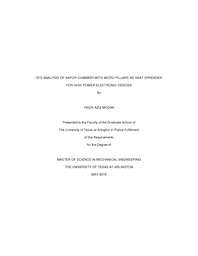
ATTENTION: The works hosted here are being migrated to a new repository that will consolidate resources, improve discoverability, and better show UTA's research impact on the global community. We will update authors as the migration progresses. Please see MavMatrix for more information.
Show simple item record
| dc.contributor.advisor | Agonafer, Dereje | |
| dc.creator | Modak, Yasir Aziz | |
| dc.date.accessioned | 2016-09-28T18:27:11Z | |
| dc.date.available | 2016-09-28T18:27:11Z | |
| dc.date.created | 2016-05 | |
| dc.date.issued | 2016-05-10 | |
| dc.date.submitted | May 2016 | |
| dc.identifier.uri | http://hdl.handle.net/10106/25914 | |
| dc.description.abstract | The recent trend in electronic industry shows that there is large power dissipation from the electronic devices and at the same time their sizes are getting smaller. This large power dissipation takes place in the form of releasing heat energy. It is observed that heat dissipation from the electronic devices is high and source size is small. The high device temperatures result in decreased reliability and increased failure rates. This difficulty can be addressed by controlling the temperatures at the source of heat generation. In chip scale package chip is the major source of heat generation. Thus our priority is to keep the junction temperature as low as possible at given thermal design power. This is usually achieved by using finned heat sinks at the top of the package.
A heat sink is designed to maximize its surface area in contact with the cooling medium surrounding it, such as the air. The amount of heat transferred by the heat sink to the air depends on the surface area of heat sink and air flowing over it. The surface area of heat sink is dictated by parameters such as weight, noise, availability of space, vibrations, surroundings, cost etc. Spreading resistance occurs due to small size source attached at the base of large heat sink.
The research provides an aggressive approach to control or eliminate spreading resistance by developing a vapor chamber heat sink with micro pillars. The two phase heat transfer provided by the vapor chambers deliver a higher performance and alleviate the thermal spreading resistance. The research focuses on the CFD analysis of vapor chamber with micro pillars as better heat spreader. The extensive parametric study suggests that this technology provides efficient cooling options for microelectronics. The proposed CFD model offers 14% less thermal resistance than that of conventional copper heat spreaders. | |
| dc.format.mimetype | application/pdf | |
| dc.language.iso | en_US | |
| dc.subject | CFD | |
| dc.subject | Vapor chamber | |
| dc.subject | Two phase | |
| dc.subject | Micro pillars | |
| dc.title | CFD ANALYSIS OF VAPOR CHAMBER WITH MICRO PILLARS AS HEAT SPREADER FOR HIGH POWER ELECTRONIC DEVICES | |
| dc.type | Thesis | |
| dc.degree.department | Mechanical and Aerospace Engineering | |
| dc.degree.name | Master of Engineering in Mechanical Engineering | |
| dc.date.updated | 2016-09-28T18:27:42Z | |
| thesis.degree.department | Mechanical and Aerospace Engineering | |
| thesis.degree.grantor | The University of Texas at Arlington | |
| thesis.degree.level | Masters | |
| thesis.degree.name | Master of Engineering in Mechanical Engineering | |
| dc.type.material | text | |
Files in this item
- Name:
- MODAK-THESIS-2016.pdf
- Size:
- 985.2Kb
- Format:
- PDF
This item appears in the following Collection(s)
Show simple item record


